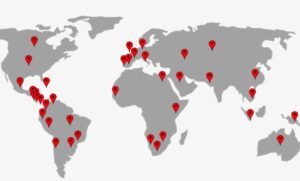Challenges and Opportunities in Nanotechnology
Patricia A. Broderick, Ph.D.
Abstract
Neuromolecular Imaging (NMI) for white matter detection, distinct from that of gray matter is an inventive art. (1) This imaging technique demonstrates, for the first time, a LIVE and continuous videotracking nanotechnology for distinguishing white matter from gray matter in the brain of epilepsy patients, online, in real time and for long periods of time. NMI is known to perform with unrivaled temporal and spatial operational reliability and reproducibility Thus, a nanotechnology for white matter disorders, for example, leukodystrophies, is published for the first time. The purpose of this paper is to present a critical distinction for white versus gray matter in hippocampal and neocortical resected tissue derived from mesial and neocortical temporal lobe epilepsy patients en bloc during intraoperative surgery; the patients present as medically refractory to classical pharmacotherapeutics. The tiny carbon-based lipid polymeric sensor, the BRODERICK PROBE® readily sees white matter in contrast to gray matter in brain neuroanatomic substrates as it continually senses the glia or the neuron, white or gray matter, respectively, with distinct clarity via electroactive signal processing. The difference between white and gray matter is striking as the videotrace slides smoothly from the white to the gray milieu. Thus, a primary in vivo white matter nanotechnology is presented to advance diagnosis and therapy for white and gray matter abnormalities in the brain and spinal cord.
Ruxana T. Sadikot
Emory University, Atlanta, GA, USA
Abstract
Nanomedicine is a rapidly emerging interdisciplinary field in which medicine is coupled with nanotechnology tools and techniques for advanced therapy with the aid of molecular knowledge. Nanoscale drug delivery systems provide a platform to improve the pharmacokinetics and increase the bio-distribution of therapeutic agents to target organs, thereby resulting in improved efficacy while limiting drug toxicity. These systems have revolutionized drug delivery approaches and are exploited for therapeutic purposes to carry the drug in the body in a controlled manner from the site of administration to the therapeutic target. Several promising molecular targets that have been identified as potential therapies for acute and chronic respiratory conditions have been limited because of difficulty with delivery systems. In particular, delivery of peptides, proteins, miRNAs to the lung is an ongoing challenge. Hence, it is an attractive strategy to test potential targets by employing a nanotechnology approach. Nanobiotechnology and nanoscience can provide innovative techniques to deliver drugs targeted to the site of inflamed organs. Here we review some of the nanomedicine approaches that have been proposed and studied over the last decade to facilitate the delivery of therapeutic agents specifically for acute and chronic lung diseases. Development of nano-sized carriers including nanoparticles, or liposomes holds great potential for diagnosis and advanced delivery systems for immunomodulation in respiratory diseases; however translational studies are urgently needed to validate the use of nanotechnology for clinical applications.
Soumya Sonalika
Associate Professor, Dept. of Community Health Nursing, Kalinga Institute of Nursing Sciences,KIIT -DU, Odisha
Sushree Sangita Mishra
Community Health Officer, Derabish, Kendrapara, Odisha
Subhashree Mahapatro
Assistant Professor, Kalinga Institute of Nursing Sciences, KIIT -DU, Odisha
Devasmita Sahoo
Assistant Professor, Kalinga Institute of Nursing Sciences, KIIT -DU, Odisha
Abstract
Introduction: Breast cancer is a global health concern, accounting for significant morbidity and mortality among women. The fragile ill prepared healthcare systems in low- & middle-income countries need to address these challenges find solutions with their limited resources.
Objectives: Through a critical examination of the literature, this article aims to contribute to a better understanding of breast cancer and to stimulate further research in this field.
Methods & Analysis: This review article provides an in-depth analysis of the current state of breast cancer research, focusing on advancements in diagnosis, treatment, and prevention, as well as the challenges and future directions.
Conclusion: Emerging technologies, such as AI, 3D bioprinting, and nanotechnology, hold promise for addressing the challenges like management of metastatic disease, global disparities in outcomes, and the need for a better understanding of breast cancer etiology and revolutionizing breast cancer care.
Patricia Ann Broderick
City College of New York, CUNY School of Medicine
Leslie Wenning
City University of New York (CUNY) School of Medicine
Abstract
Temporal synchrony, discovered in our laboratory using Live Imaging, Neuromolecular Imaging (NMI), and the BRODERICK PROBE® reveals a distinctive rhythmic regularity between neurotransmitter synaptic release and movement frequency in the natural, physiologic state. Using this innovative nanotechnology of NMI and BRODERICK PROBE® nanobiosensors, a point-by-point temporal synchrony was imaged between the synaptic concentration of serotonin (5-HT) released from structures such as dorsal striatum A9 and ventral striatum A10 terminals, basal nucleus, and ventrolateral nucleus accumbens (vlNAcc) in concert with natural open-field behaviors such as ambulating movement and finer movements of grooming, licking, and chewing. Indeed, 5-HT synaptic concentration increased and decreased in parallel and simultaneously with the rise and fall of open-field behavior frequency. Thus, temporal synchrony occurs when the symphony of physiologic neurochemistry and behavior is uninterrupted by drugs, disease, or injury. In contrast, neurotransmitter release and movement frequency are not in concert when monitoring, for example, psychostimulant-induced behaviors produced by cocaine. After cocaine administration, NMI and BRODERICK PROBE® nanobiosensors revealed temporal asynchrony between endogenous 5-HT release at A10 terminals, basal stem nucleus, somatodendrites, and VTA and both cocaine-induced ambulations and fine movements in freely moving, male Sprague Dawley animals.
Temporal asynchrony was also seen during intraoperative, in vivo studies of neurotransmitter release in anterior temporal lobe epilepsy in a human patient. It is likely that time sensitive asynchrony occurred due to the chemical movement of neurotransmitters away from catecholamine and indoleamine neurotransmitters to excitatory neural transmission via the neuropeptide, dynorphin 1-17, that is readily imaged by NMI. NMI recordings with laminar biocompatible carbon-based BRODERICK PROBE® nanobiosensors were taken at a cortical depth of microns to less than 2 mm for 20-30 minute intervals in the epilepsy patient during resection surgery intraoperatively. Importantly, L-tryptophan (L-TP) was imaged online during the operation showing the lack of the ability of the asynchronous brain to produce 5-HT, the hallmark of the synchronous natural state of physiology. Therefore, L-TP and neuropeptides such as excitatory Dynorphins may serve as neurobiomarkers for pharmaco- and/or gene therapy for neurodegenerative processes. In this manner, temporal patterns may be used to create a dynamic data profile in the clinical setting. Although static neurotransmitter levels are currently the standard, these static parameters become more valuable when empirically studied within the context of movement rather than solely focusing on whether a neurotransmitter level has increased or decreased. Not only does this dynamic data provide a more complete portrait of the temporal harmony of physiology, but it may also be used to distinguish the intensity of disease or drug-induced temporal cacophony on specific parts of microneuroanatomy. Therefore, a rhythmic brain, disrupted, may well define brain disease.



